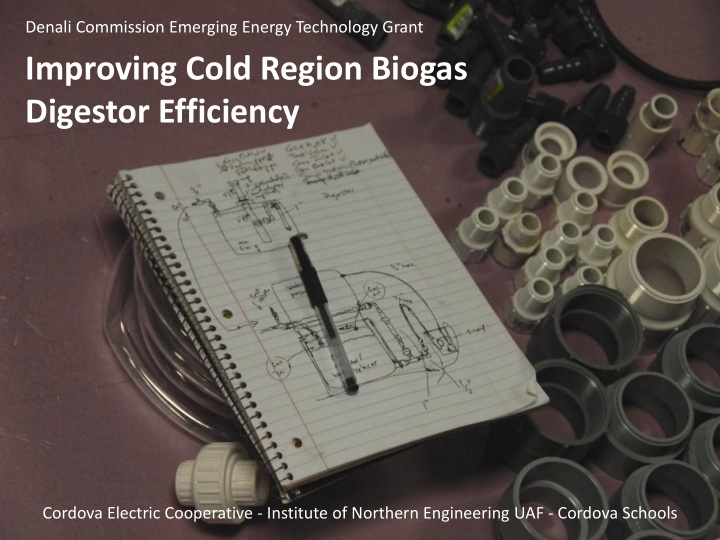



Denali Commission Emerging Energy Technology Grant Improving Cold Region Biogas Digestor Efficiency Cordova Electric Cooperative - Institute of Northern Engineering UAF - Cordova Schools
Climate limitation of conventional biogas production (59 ° F)
Project Summary • Experiment with cold-loving microbes ( psychrophiles ) to improve efficiency in biogas digestors for generating cooking and heating gas for Alaskan households. • Phase 1: Compare efficiencies of warm-loving, conventional digestor microbes ( mesophiles ) and psychrophiles on common Alaskan feedstock at various temperatures. • Phase 2: Application of digestors in practical household scale projects to operate appliances and an electrical generator to evaluate feasibility and sustainability for widespread use in Alaska.
Project Partners Clay Koplin Project Manager Cordova Electric Cooperative Executive Adam Low Dennis Rose, Mgr. Dr. Katey Walter Anthony Director of Operations Feedstock Donor Principal Investigator Cordova Schools AC Value Center INE UAF T H Culhane High School Students Engineers Laurel McFadden Expert Consultant Research Technicians INE UAF Peter Anthony Solar Cities Cordova Schools Technical Assistants INE UAF Collaborators: Autumn Bryson, Native Village of Eyak Bernie Karl, Chena Hot Springs Erika Behrends, Cordova Schools
Biogas Biogas is a flammable gas created by bacterial degradation of an organic food source, roughly: ~60% methane (CH 4 ) ~35% carbon dioxide (CO 2 ) ~5% other gases Biogas can be used as a fuel source in gas- burning technologies, such as - stoves - heaters - lights - electrical generators
Methanogens ARE: bacteria that produce methane (CH 4 , biogas) HOW: anaerobic process, consortium of hydrolytic and fermentative bacteria WHERE: anywhere with the right environmental conditions and food source Organic Material 1 Monomers 1 1 1 Fatty acids, alcohols 2 Acetate C-1 Compounds, H 2 3 4 4 CH 4 , CO 2 NASA and STScI Biogas production is highly dependent on: Temperature, pH, nutrient availability, and carbon/nitrogen ratios
How can we use methanogens to produce a low-cost, sustainable supply of biogas as an alternative energy source? Mimic their natural optimal environment and methanogens will naturally supply a continual source of biogas. The beginnings of digestor technology: Ruminant digestion systems
Conventional Digestor Technology Collect ruminant manure: -warm-loving microbial source -feedstock source Mix with water and seal in primary tank -microbes consume O 2 naturally anaerobic conditions -biogas production starts -2 to 4 weeks later (temperature dependent), biogas burns Utilization: - Direct methane to a biogas-burning technology http://enviro-toons.com/page2.html
Problems with traditional digestors PROBLEM #1: manure is a nutrient-poor resource SOLUTION: supply high-quality feedstock (rich in sugar and starch) for optimal biogas production – such as household organic waste PROBLEM #2: temperature limitation The bacterial populations in ruminant digestion tracks are warm-loving microbes ( mesophiles ). • Optimal methane production at 37 ° C • Shuts down at 15°C • Standard digestor technology only works if - the equipment is built in warm climates - the equipment is kept heated, at fuel costs SOLUTION: Improve biogas production for people who live in cold climates by inoculating digestors with cold-loving, Arctic methanogens ( psychrophiles ).
Where do we find cold-loving methanogens? Alaskan thermokarst-lake sediments • Methane production at 0-1°C to 21°C • Recently discovered (Zimov et al. Science 1997; Walter et al. Nature 2006) • 4x more efficient than European psychrophiles that live at 5°C
Cordova Experimental Digestor Set-up
Phase 1 Test Design Cold Room: 15C Warm Room: 25C Psychrophiles Psychrophiles Mixed Psychrophiles Mixed Psychrophiles and Mesophiles and Mesophiles Mesophiles Mesophiles
Collecting the Methanogens Picking up manure at the Northern Lights Dairy farm in Delta Junction (mesophile collection) Coring for mud in Fairbanks (psychrophile collection)
New Pressurizing Design Implement closed-tank system with water-pressure technology in tandem
Construction
Working at the Cordova High School
Data Monitoring: Gas Flow
Biogas Flame Test First Biogas Digestor Produced 1 1/31/2010 2 NA 3 1/22/2010 4 2/1/2010 5 1/21/2010 Digestors sealed on January 19, 2010 6 1/26/2010
Data Monitoring: Chemistry Digestor #3: Interior Tank Temperature Trend 18.0 16.0 14.0 12.0 Temperautre (C) 10.0 8.0 6.0 4.0 2.0 0.0 Date (mm/dd/yyyy)
Digestor #1: ORP Trend 40 Oxidation/Reduction Potential (mV) 20 0 1/27/2010 1/28/2010 1/29/2010 1/30/2010 1/31/2010 2/1/2010 2/2/2010 2/3/2010 -20 -40 -60 -80 -100 -120 -140 -160 Date (mm/dd/yyyy) Digestor #5: Dissolved Oxygen Trend 4.5 4.0 3.5 Dissolved Oxygen 3.0 2.5 2.0 1.5 1.0 0.5 0.0 Date (mm/dd/yyyy)
Challenges Experienced Freezing - Water pressure system risks freezing and breaking pipes at temperatures below 32F Maintaining optimal slurry temperature - Energy expenditure in keeping microbes comfortable Time costs -Designing feasible feeding regimen for students -Balancing scientific rigor with enthusiasm for immediate application Availability of construction materials -Limited local resources, extensive time required to gather necessary start-up equipment Determining economic feasibility - Need more flow data and progress to Phase 2
Solutions and Progress Include antifreeze or water-bucket heater to prevent freezing in water pressure system Extensive insulation of tanks to maintain temperature Utilize recycling opportunities and work within local resources
Solutions and Progress Student-designed ideas for easier feeding procedures Beginning construction manual
Phase 2 : Deploy digestors to fuel appliances and an electrical generator to evaluate feasibility and sustainability for widespread use in Alaska ~1,200 L day -1 = biogas production gas lights infrared heater 200-300 L hr -1 hot water heater 125-150 L day -1 cook stove electrical generator 1000 L kWh -1 150-300 L meal -1 Usage estimates from GTZ
Biogas Technology Benefits • Produces a renewable, alternative fuel from locally available resources • Mitigates health and environmental safety problems associated with waste disposal in Alaska • Reduces fossil fuel demands in rural Alaskan communities, lowering high fuel expenditures and fuel transportation risks • Produces fertilizer for Alaskan agricultural efforts • Counteracts the greenhouse effects of methane previously released directly into the atmosphere • Empowers local and individual contributions to mitigating the global greenhouse effect • Puts Alaska at the head of cold-adapted digestors globally and makes Alaska one of the initiating areas to use digestors in the USA
Questions?
Recommend
More recommend